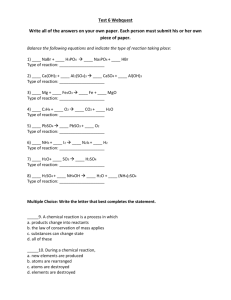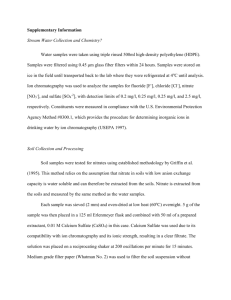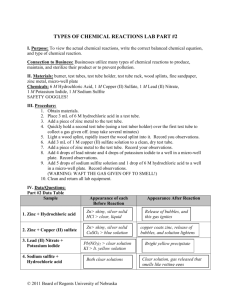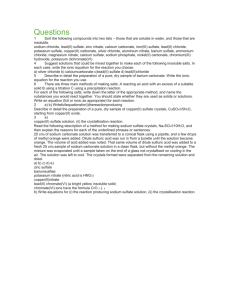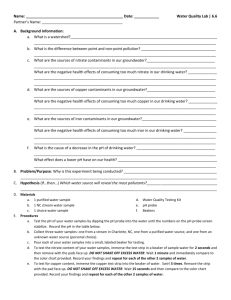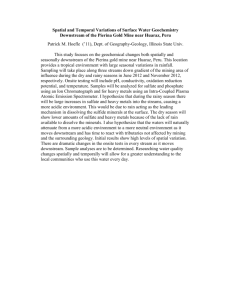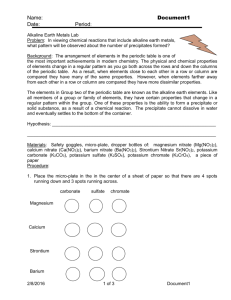Lab 1 Investigating the Activity Series of Metals
advertisement
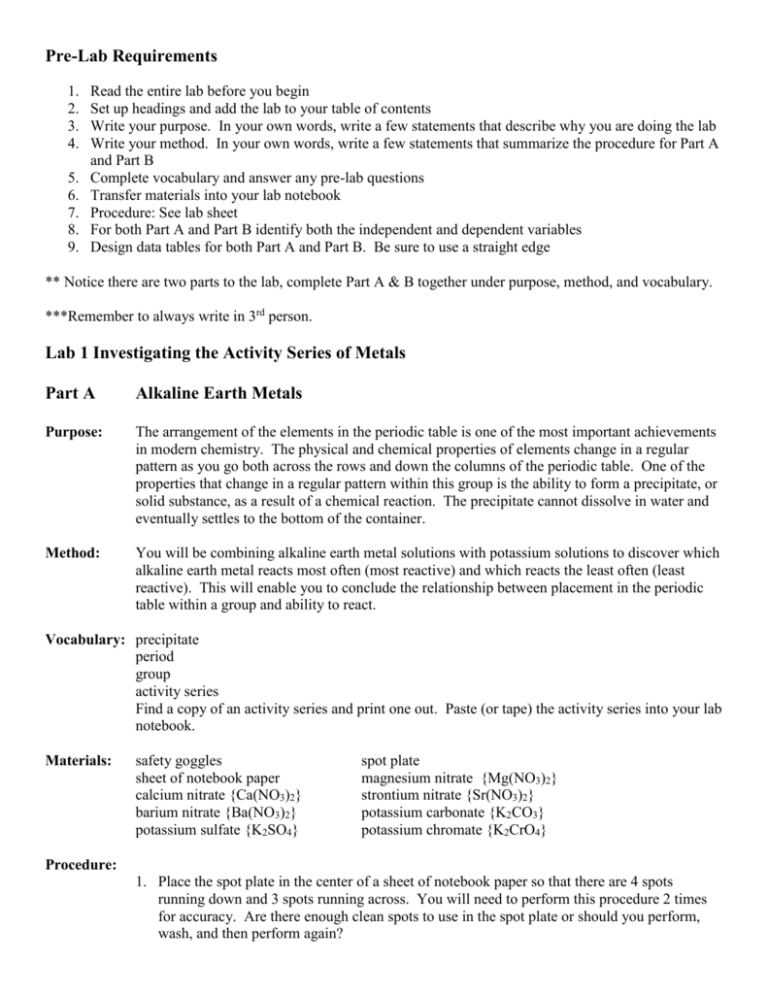
Pre-Lab Requirements
1.
2.
3.
4.
5.
6.
7.
8.
9.
Read the entire lab before you begin
Set up headings and add the lab to your table of contents
Write your purpose. In your own words, write a few statements that describe why you are doing the lab
Write your method. In your own words, write a few statements that summarize the procedure for Part A
and Part B
Complete vocabulary and answer any pre-lab questions
Transfer materials into your lab notebook
Procedure: See lab sheet
For both Part A and Part B identify both the independent and dependent variables
Design data tables for both Part A and Part B. Be sure to use a straight edge
** Notice there are two parts to the lab, complete Part A & B together under purpose, method, and vocabulary.
***Remember to always write in 3rd person.
Lab 1 Investigating the Activity Series of Metals
Part A
Alkaline Earth Metals
Purpose:
The arrangement of the elements in the periodic table is one of the most important achievements
in modern chemistry. The physical and chemical properties of elements change in a regular
pattern as you go both across the rows and down the columns of the periodic table. One of the
properties that change in a regular pattern within this group is the ability to form a precipitate, or
solid substance, as a result of a chemical reaction. The precipitate cannot dissolve in water and
eventually settles to the bottom of the container.
Method:
You will be combining alkaline earth metal solutions with potassium solutions to discover which
alkaline earth metal reacts most often (most reactive) and which reacts the least often (least
reactive). This will enable you to conclude the relationship between placement in the periodic
table within a group and ability to react.
Vocabulary: precipitate
period
group
activity series
Find a copy of an activity series and print one out. Paste (or tape) the activity series into your lab
notebook.
Materials:
safety goggles
sheet of notebook paper
calcium nitrate {Ca(NO3)2}
barium nitrate {Ba(NO3)2}
potassium sulfate {K2SO4}
spot plate
magnesium nitrate {Mg(NO3)2}
strontium nitrate {Sr(NO3)2}
potassium carbonate {K2CO3}
potassium chromate {K2CrO4}
Procedure:
1. Place the spot plate in the center of a sheet of notebook paper so that there are 4 spots
running down and 3 spots running across. You will need to perform this procedure 2 times
for accuracy. Are there enough clean spots to use in the spot plate or should you perform,
wash, and then perform again?
2. Along the side of the notebook paper next to each of the four spots, write the names of the
four alkaline earth metals that are present in each nitrate compound listed in the materials
you are using. Along the top of the notebook paper write the names of each of the three
potassium compounds you are using. See figure below.
carbonate
sulfate
chromate
Ba
Sr Ca Mg
3. Put on your safety goggles. Place several drops of potassium carbonate in each of the four
spots under the word “carbonate”. Place several drops of potassium sulfate in each of the
four spots under the word “sulfate”. Place several drops of potassium chromate in each of the
four spots under the word “chromate”. Be very careful not to mix the liquid from one spot
with the liquid from another.
4. Take the dropper of magnesium nitrate and place several drops in each of the three spots in
the row labeled “magnesium”. Observe each spot carefully and record the result in the data
table. Repeat this procedure using the dropper battles containing calcium, strontium, and
barium. Be careful not to mix the liquid from one spot with the liquid from another.
5. After recording your results, wash your spot plate thoroughly with a brush. Do you have a
total of 2 sets of results?
Analysis:
Was there evidence of a chemical reaction occurring in any of the spots? Explain.
If the ability of an alkaline earth element to form a precipitate is an indication of its ability to
chemically react with other substances, which is the most reactive element? the least reactive
element?
Conclusions:
How does the order of the alkaline earth metals from most reactive to least reactive compare
with their order in the periodic table?
Based on the investigation, list the alkali metals (group IA) in order from most reactive to
least reactive.
If there is a solution containing a mixture of calcium and strontium, how could the two
elements be separated? (HINT: precipitates can be filtered)
Part B
Transition Metals
Purpose:
The purpose of this lab is to arrange several metals in the periodic table in order
of their activity. A metal is said to be more active than another metal if it will replace the less
active metal from a solution of one of its compounds.
Method:
Students will test zinc, copper, and lead to see if they will replace one another in
solutions of their compounds in order to develop a list of metals in order of their activity.
Materials:
copper sulfate
Zinc sulfate
Lead Nitrate
Procedure:
1. Arrange the nine test tubes in three groups of three each. Using a piece of
paper, label three test tubes “lead nitrate”, three “zinc sulfate”, and three “copper sulfate”
2. Fill the appropriately labeled three test tubes one-fourth full of lead nitrate solution. Repeat
for the zinc sulfate and the copper sulfate.
3. Place a strip of lead in each of the three compound solutions, lead nitrate, copper sulfate, and
zinc sulfate. Repeat for strips of zinc and copper.
4. After several (maybe 10 or more?) minutes, remove the strips from the solutions with a
tweezers and examine them for evidence of a reaction. Record your observations in the data
table.
Analysis:
lead strip (3 cm)
zinc strip (3 cm)
copper strip (3 cm)
9 small test tubes
test-tube rack
safety goggles
List the metals in order of decreasing activity.
How can it be determined which of the three metals is the most active?
Compare your list of metals to the activity series of metals.
Conclusion:
Magnesium is more active than zinc. How would a strip of magnesium have
reacted in each of the three solutions in this investigation?
Tin is less active than zinc but more active than lead. How would a strip of tin have reacted
in each of the three solutions in this investigation?
If a strip of silver does not react with any of the three solutions tested in this investigation,
what must be true about silver?
Describe how it could be determined if iron is more active than copper.
If a strip of silver turns dark in a nickel nitrate solution, what is true?
If Rb does not react in a copper nitrate solution, what is true?
Is it possible to determine the reactivity of a transition metal by looking at its location on the
periodic table?

